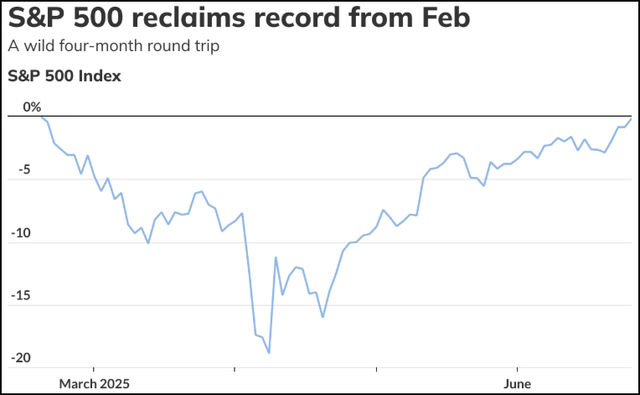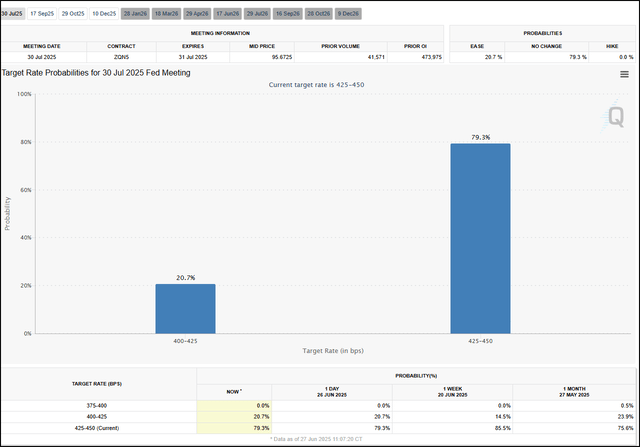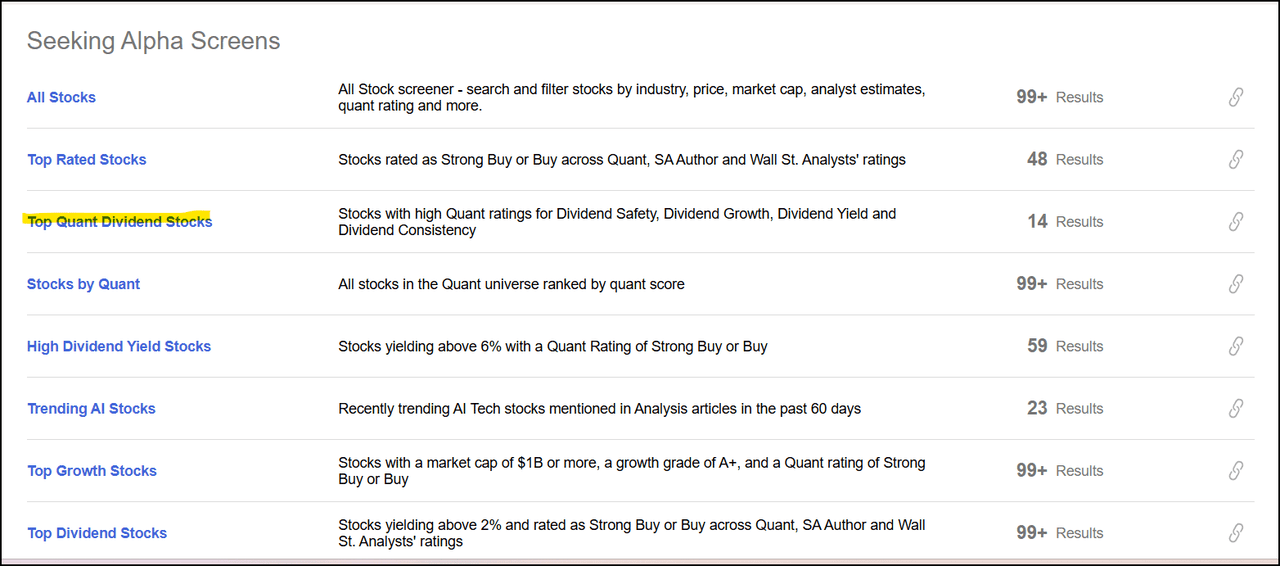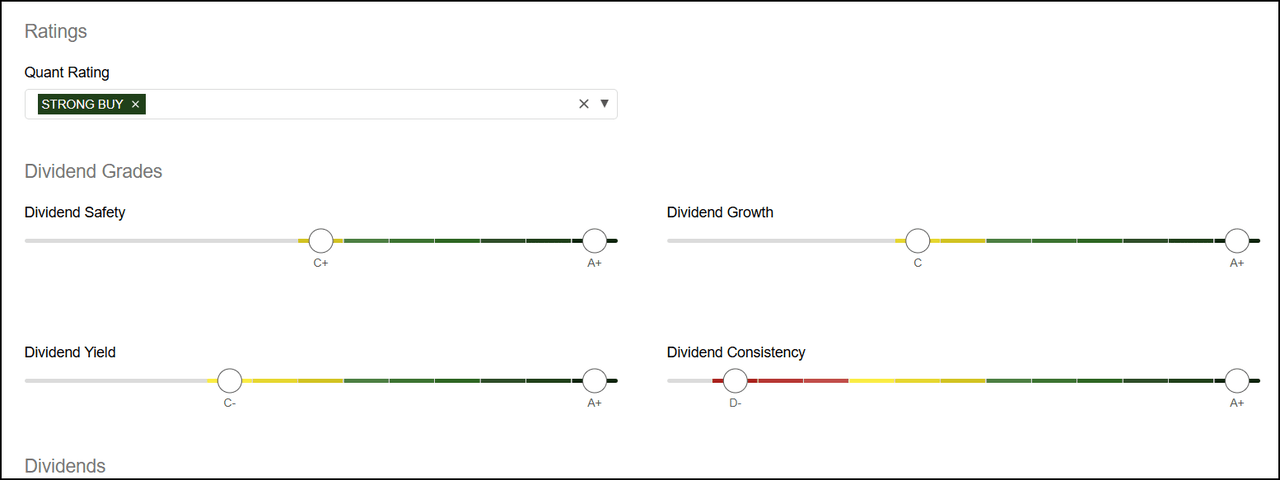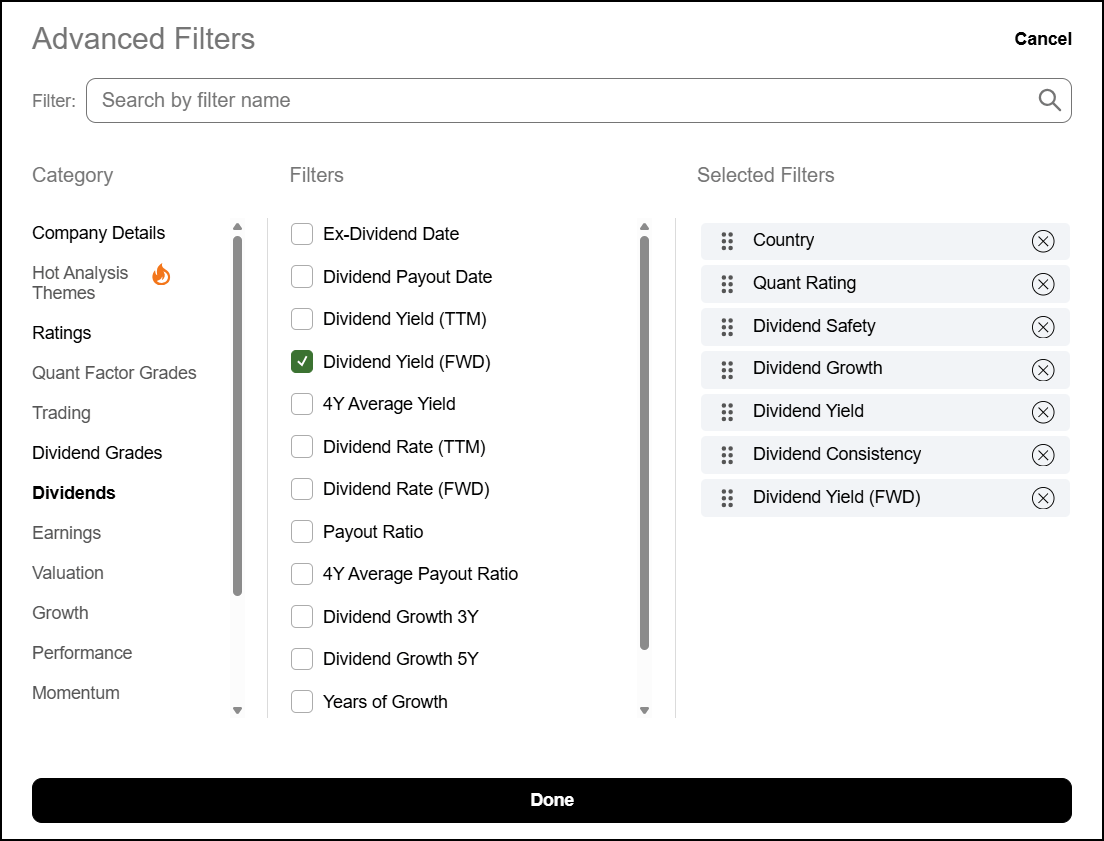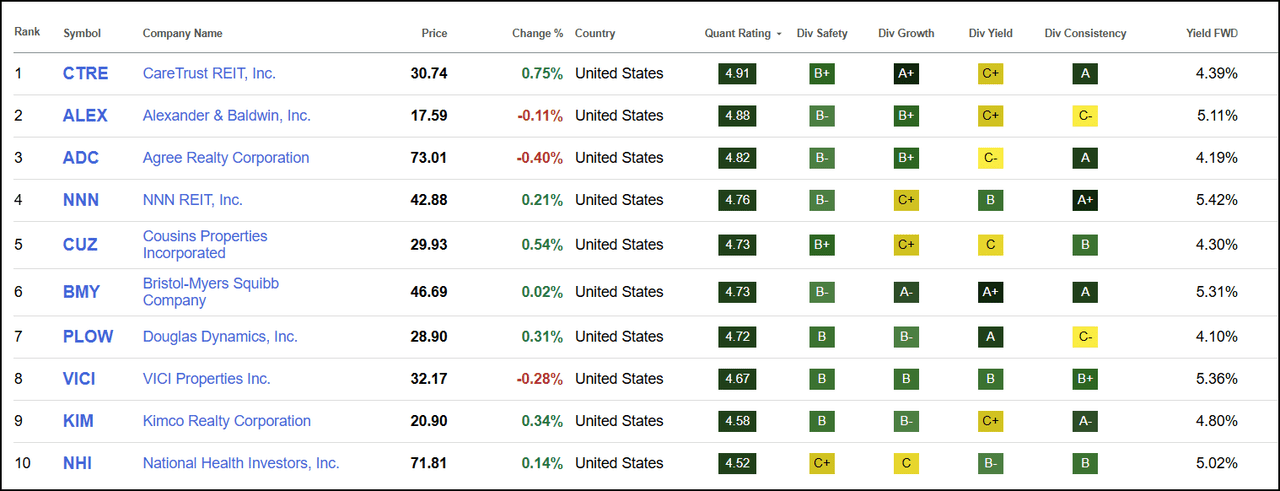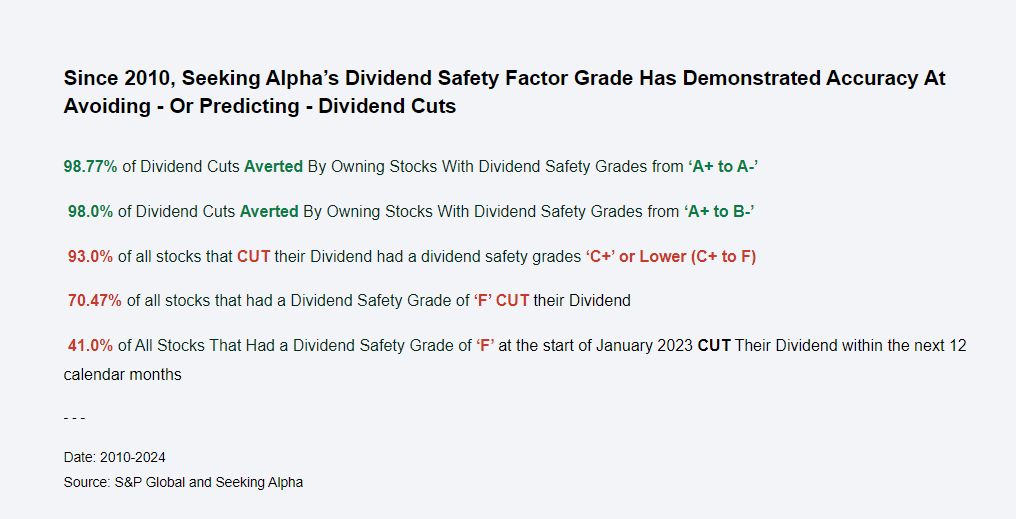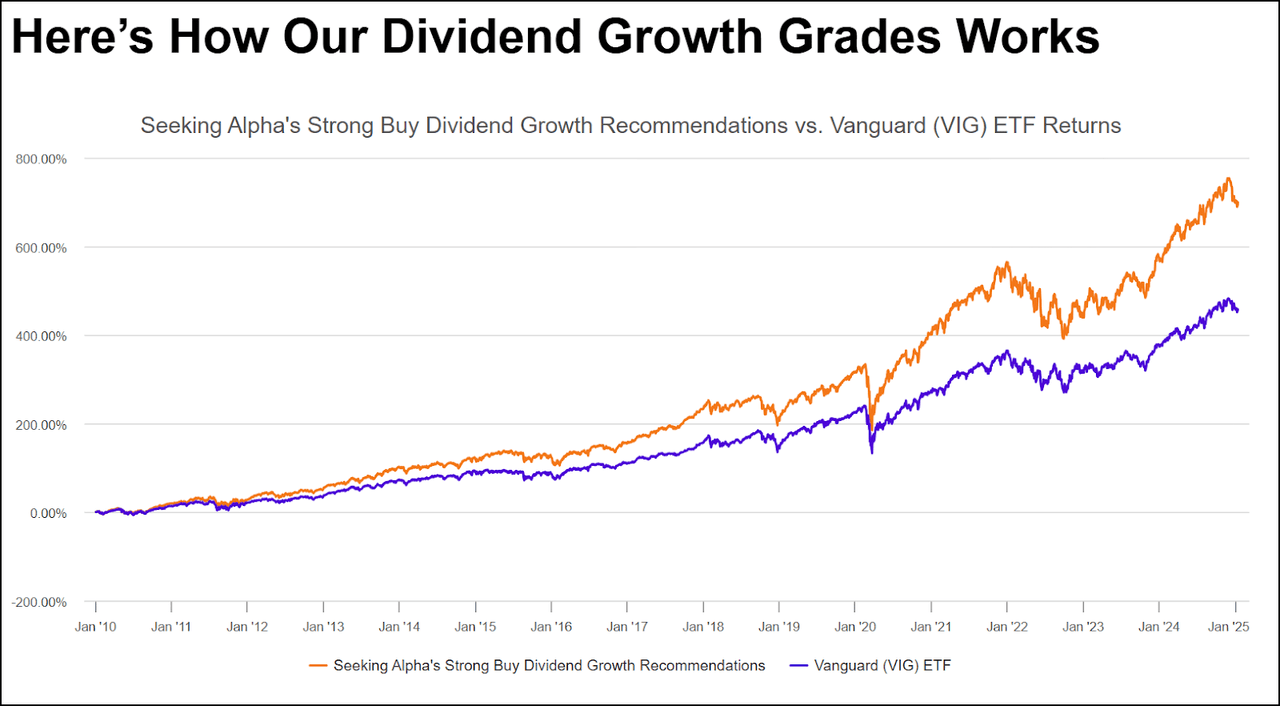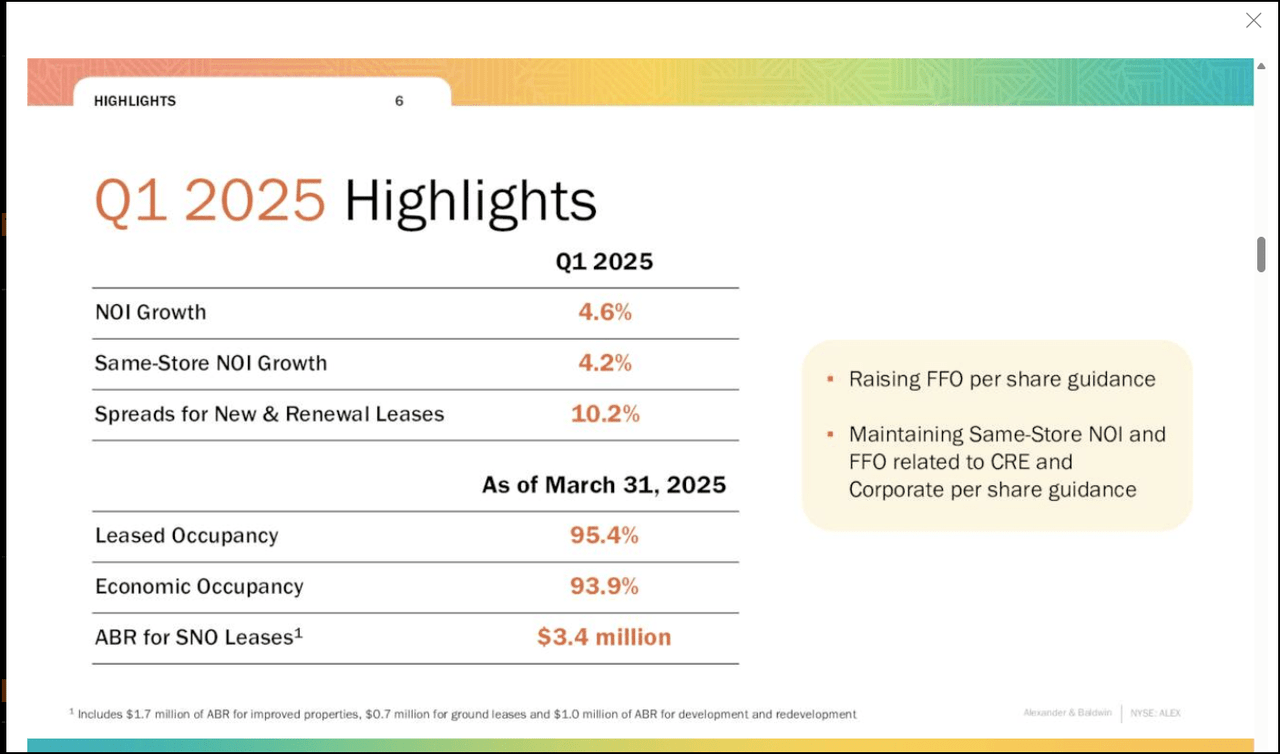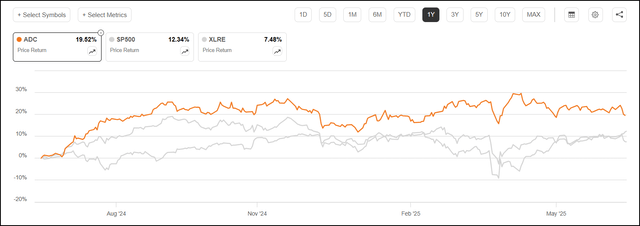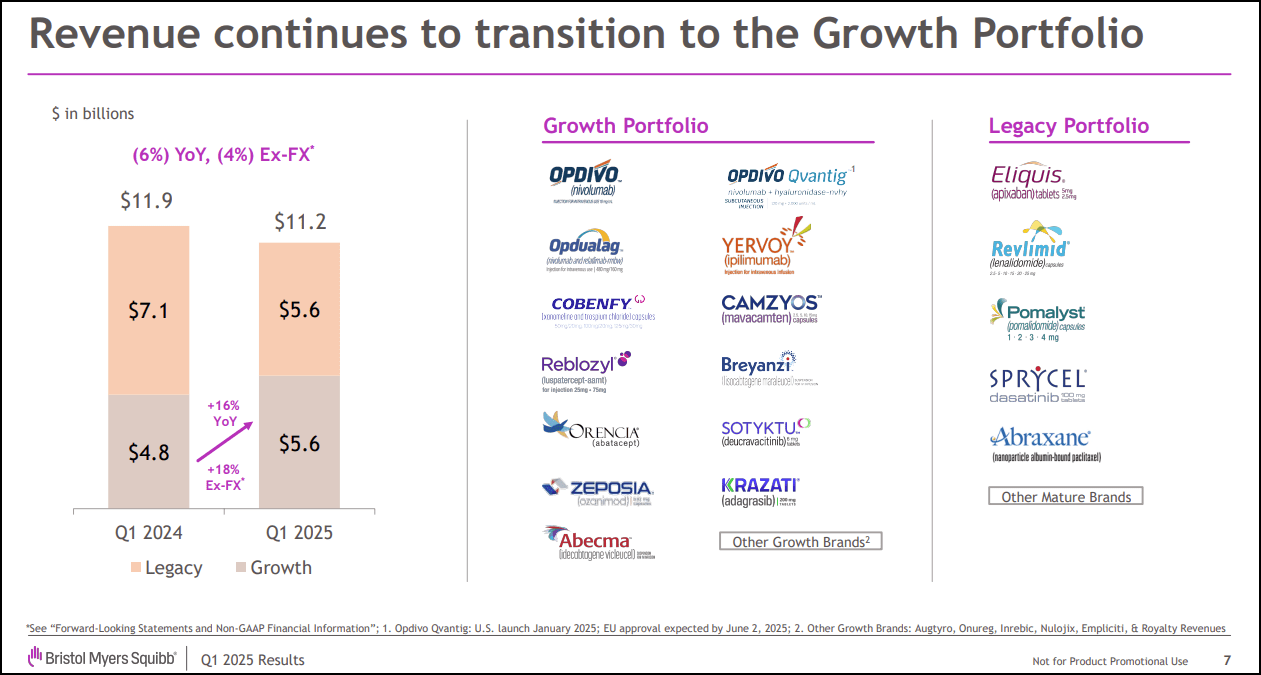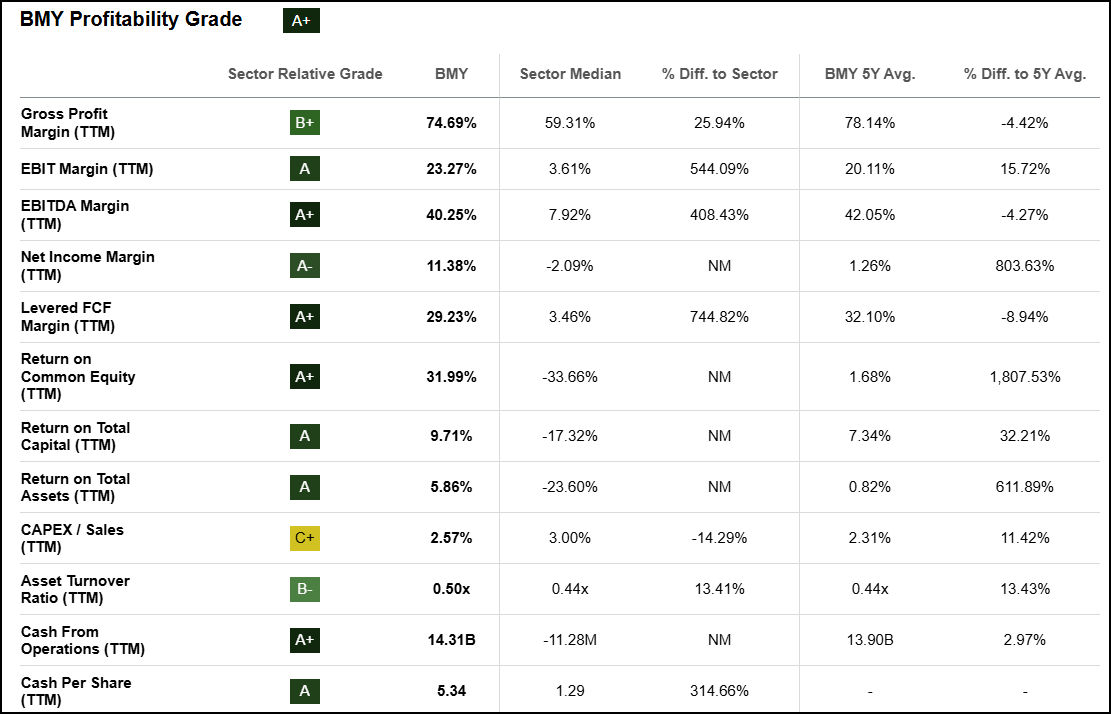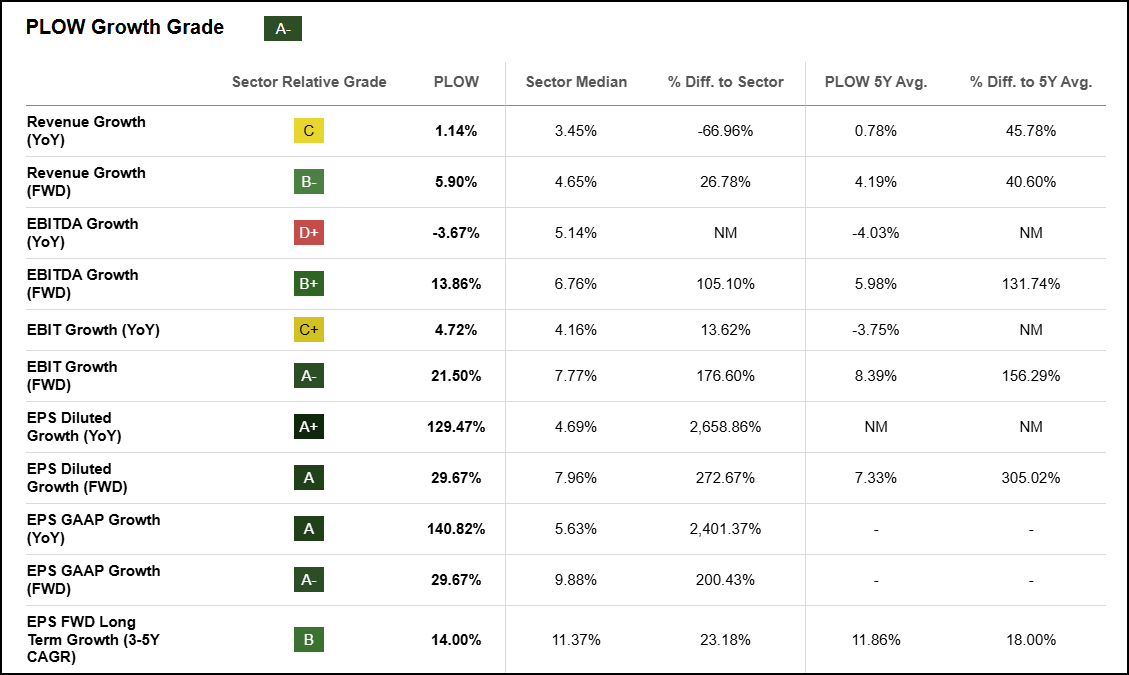How to Live Off
$500,000… Practically Forever
In this income investing report, you’ll discover…
- How the 4% Rule and 60/40 Portfolio are now dead.
- 12 popular dividend disasters you need to dump right now.
- How you could bank tens of thousands of dollars in yearly dividend cash for every $500,000 invested, and …
- 3 incredible monthly payers dishing out dividends up to 10%.
Dear Reader,
A half-million dollars is a lot of money. Unfortunately, it won’t generate much income today if you limit yourself to popular mainstream investments.
The 10-year Treasury pays around 4.3% as I write this. That’s not bad, historically speaking, but put your $500K in them and you’re only looking at $21,500, right around the poverty level for a two-person household. Yikes.
And dividend-paying stocks don’t yield nearly enough. For example, Vanguard’s popular Dividend Appreciation ETF (VIG) pays around 1.7%. Sad.
When investment income falls short, retirees are often forced to sell their investments to supplement their income.
Of course, the problem here is that when capital is sold, the payout stream takes an immediate hit – so that more capital must be sold next time, and so on.
Avoid the Share Selling “Death Spiral”
Some financial advisors (who are not retired themselves, by the way) say that you can safely withdraw and spend, say, 4% of your retirement portfolio every year. Or whatever percentage they manipulate their spreadsheet to say.
Problem is, in reality, every few years you’re faced with a chart that looks like this.
Apple’s Dividend Was Fine – Its Stock Wasn’t

As you can see, the dividend (orange line above) is fine — growing, even — but you’re selling at a 25% loss!
In other words, you’re forced to sell more shares to supplement your income when they’re depressed.
Remember the benefits of dollar-cost averaging that built your portfolio? You bought regularly, and were able to buy more shares when prices were low?
In this case, you’re forced to sell more shares when prices are low.
When shares rebound, you need an even bigger gain just to get back to your original value.
The Only Reliable Retirement Solution
Instead of ever selling your stocks, you should instead make sure you live on dividends alone so that you never have to touch your capital.
This is easier said than done, and obviously the more money you have, the better off you are. But with yields still pretty low, even rich folks are having a tough time living off of interest today.
And you can actually live better than they can off of a (much) more modest nest egg if you know where to look for lesser-known, meaningful and secure yield.
I’m talking about annual income of 8%, 9% or even 10%+ so that you’re banking $50,000 (and potentially more) each year for every $500,000 you invest.
You and I both know an income stream like that is a very nice head start to a well-funded retirement.
And it’s totally scalable: Got more? Great!
We’ll keep building up your income stream, right along with your additional capital.
And you’ll never have to touch your nest egg capital – which means you won’t have to worry about or running out of money in retirement, or even the day-to-day ups and downs of the stock market.
The only thing you need to concern yourself with is the security of your dividends.
As long as your payouts are safe, who cares if your stock prices swing up or down on a given day?
Most investors know this is the right approach to retirement.
Problem is, they don’t know how to find 8%, and 10% yields to fund their lives.
And when they do find high yields, they’re not sure if these payouts are safe. Will the company or fund have enough cash flow to pay the dividends into the future?
And how sensitive are these payouts to the latest headline, Fed policy changes or unrest on the other side of the globe?
We’ll talk specific stocks, funds and yields in a moment.
But first, a bit about myself.
I graduated cum laude with an industrial engineering degree — which is actually pretty popular with Wall Street recruiters.
But I couldn’t stand the thought of grinding it out in a cubicle for 80 hours a week. So I moved to San Francisco and got into the tech scene.
A buddy and I started up two software companies that serve more than 26,000 business users.
The result was a nice chunk of change coming in … and I had to decide what to do with my money.
I had seen plenty of young “techies” come into sudden cash and burn through their windfall in a year, ending up right back where they started.
That was NOT going to be me. I already had dreams of living off my wealth one day, decades before I retired.
I got plenty of cold calls from brokers wanting to “help” me. But I knew that nobody would care as much about my money as me.
So I went out on my own and invested my startup profits in dividend-paying stocks.
I’ve been hunting down safe, stable and generous yields ever since, growing my wealth with vehicles paying me 8%, 9%, even 10%+ dividends.
Over the past 10+ years, I’ve been writing about the methods I use to generate these high levels of income.
Today I serve as chief investment strategist for Contrarian Income Report — a publication that uncovers secure, high-yielding investments for thousands of investors.
Since inception, my subscribers have enjoyed dividends 5 times (and much more!) the S&P 500 average, plus big annualized gains!
And that brings me to a crucial piece of advice…
The ONE Thing You Must Remember
If I could leave you with just one nugget of investing wisdom today, it would be to NEVER overlook the incredible wealth-building power of dividends.
Few investors realize how important these unglamorous workhorses actually are.
Here’s a perfect example…
If you put $1,000 in the dividend-paying stocks of the S&P 500 back in 1973, you would have had $87,560 by 2023, or 87x your money.
But the same $1,000 in the non-dividend payers would have grown to just $8,430 — 90% less.
That’s why I’m a dividend fan.
The stock market is a fantastic wealth-building machine, but it doesn’t always go straight up!
There have been plenty of 10-year periods where the only money investors made was in dividends.
And that’s what gives us dividend investors such an edge.
When you lock in an 8%+ yield, you’re booking an income stream that’s bigger than the stock market’s long-term average return right off the bat.
Of course you can’t just buy every ticker symbol out there with a flashy yield, or you’ll get burned pretty fast.
So let’s wipe the false promises of mainstream finance from our minds and start thinking the “No Withdrawal” way…
Step 1: Forget “Buy and Hope” Investing
Most half-million-dollar stashes are piled into “America’s ticker” SPY.
The SPDR S&P 500 ETF (SPY) is the most popular symbol in the land. For many 401(K)’s, this is all there is.
And that’s sad for two reasons.
First, SPY yields just 1.2%. That’s $6,000 per year on $500K invested… poverty level stuff.
Second, consider 2022 for a moment (and only a moment, I promise!).
SPY was down nearly 20% that year. That is no bueno, because that $500K would have been reduced to $400K.
The last thing we want to do is lose the money we’re getting in dividends (or more) to losses in the share price. Which is why we must protect our capital at all costs.
Step 2: Ditch 60/40, Too
The 60/40 portfolio has been exposed as senseless.
Retirees were sold a bill of goods when promised that a 60% slice of stocks and 40% of bonds would somehow be a “safe mix” that would not drop together.
Oops.
Inflation — plus an aggressive Federal Reserve, plus a (thus far) persistently steady economy — drop-kicked equities and fixed income before they went on a serious bull run in 2023 and 2024.
It just goes to show that bonds are not the haven guaranteed by the 60/40 high priests. They could easily plunge just as hard (or harder) than stocks in the next economic crisis.
Just like they did in 2022 (sorry, we’re only going to spend one more second on that disaster of a year). US Treasuries plunged, which resulted in the iShares 20+ Year Treasury Bond ETF (TLT) getting tagged.
Sure, it still paid its dividend. But even including payouts, the fund was down 31% — worse than the S&P 500. Ouch!
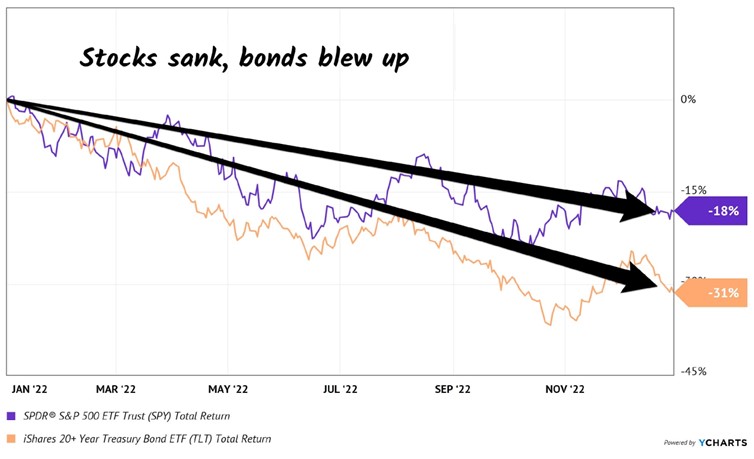
When stocks and bonds are dicey, where do we turn? To a better bet.
A strategy to retire on dividends alone that leaves that beautiful pile of cash untouched.
Step 3: Create a “No Withdrawal” Portfolio
My colleague Tom Jacobs and I literally wrote the book on a dividend-powered retirement.
In How to Retire on Dividends: Earn a Safe 8%, Leave Your Principal Intact, we outline our “no withdrawal” approach to retirement:
- Save a bunch of money. (“Check.”)
- Buy safe dividend stocks with big yields
- Enjoy the income while keeping the original principal intact.
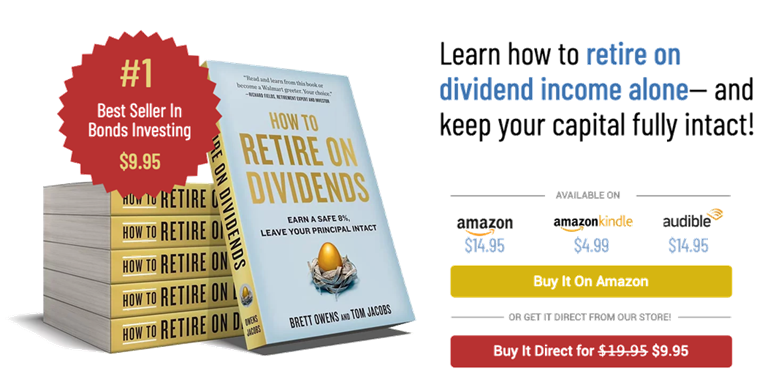
To make that nest egg last, and our working life worthwhile, we really need yields in the 7% to 10% range. We typically don’t see these stocks touted on Bloomberg or CNBC, but they are around.
Of course, there are plenty of landmines in the high-yield space. Some of these stocks are cheap for a reason. Which is why we need to be contrarian when looking for income.
We must identify why a yield is incorrectly allowed to be so high. (In other words, we need to figure out why the stock is priced so cheaply!)
As I write, the top 10 payers in my Contrarian Income Report portfolio yield about 10.6% on average.
On every million dollars invested, this dividend collection is spinning off an incredible $106,000 every single year!

And you don’t have to be a millionaire to take advantage of this strategy.
A $750k nest egg will generate $79,500 annually…
$500K could hand you $53,000…

You get the idea.
The important thing is that these yields are safe, which creates stability for the stock (and fund) prices attached to them.
We want our income, with our principal intact.
It’s really the only way to retire comfortably, without having to stare at stock tickers all day, every day.
Now, many blue-chip yields are safe. They just need to hit the gym and bulk up a bit. Here’s how we take perfectly good, yet modest, dividends and make them into braggarts.

Step 4: Supersize Those Yields
Mastercard (MA) is a near-perfect dividend stock. Its payout is always climbing, having nearly doubled over the last five years. (MA shareholders, you can thank every business that accepts Mastercard for your “pennies on every dollar” rake.)
Tap, tap, tap. Remember cash? Me neither. Another 2020 casualty, with Mastercard making a few dimes or dollars on every plastic transaction.
The cashless trend has been in motion for years. But international growth prospects remain huge. Just a few years ago, 80%+ of transactions in Spain, Italy and even tech-savvy Japan were in cash.
We expect more dividend hikes as more cash turns to plastic. Or skips plastic entirely and goes straight to e-transfers. Mastercard and close cousin Visa (V) nab a nice piece of that action, too.
The only chink in MA’s armor? Everyone knows it is a dynamic dividend stock. So it only yields 0.5%. Investors keep bidding it higher, knowing that the next dividend raise is just around the corner.
So, the compounding of those hikes makes MA a great stock for our kids and grandkids. You and I, however, don’t have the time to wait for 0.5% to grow. And $2,500 on a $500K investment simply won’t get it done.
Let’s instead consider top-notch closed-end fund (CEF) Gabelli Dividend & Income Trust (GDV), managed by legendary value investor Mario Gabelli.
Mastercard is one of Gabelli’s largest holdings. But we income investors would prefer GDV because it boasts a healthy dividend right around 6.8%, paid monthly, nearly 14 times what Mastercard pays (and this is low in CEF-land; other funds, like the next one we’ll talk about, pay nearly double that).

And today, thanks to the conservative folks who buy CEFs, we have a rare opportunity to buy Mario’s portfolio for just 87 cents on the dollar.
Yup, GDV trades at a 13% discount to its net asset value, or NAV. It’s a way to boost MA’s payout and snag a discount, too.
Where does this discount come from?
CEFs are like their mutual fund cousins, with one exception: they have fixed pools of shares, so they can (and do) trade higher and lower than their NAVs, or “fair” values (the value of their holdings minus any debt).
As contrarians, we can step in when they are temporarily out of favor, like after a pullback, when liquidity is low, and buy them at generous discounts.
GDV holds more blue-chip dividend payers alongside MA, such as American Express (AXP), Microsoft (MSFT) and JPMorgan Chase & Co. (JPM). And with GDV, we have an opportunity to purchase them at a 13% discount.
These high-quality stocks wouldn’t normally qualify for our “retire on $500K” portfolio because everyone in the world knows they are strong long-term investments.
Even though these companies are constantly raising their dividends, constant demand for their shares keeps their prices high (and current yields low). So they never meet our current-yield requirement.
GDV does. The fund pays a monthly dividend that adds up to a nice 6.8% annual yield.
Let me give you one more idea (and this is where that much larger payout comes in): the Eaton Vance Tax-Managed Global Diversified Equity (EXG) is another CEF with a similar blue-chip dividend portfolio.
But EXG generates even more income than GDV by selling covered calls on the shares it owns.
More cash flow means a bigger dividend — and EXG pays an already terrific 9.4%!
So we buy and hold EXG and GDV forever, collecting their monthly dividends merrily along the way? Not quite.
In bull markets, these funds are great. But in bear markets, they’ll chew you up.
Step 5: Protect That Principal!
My CIR readers will fondly recall the 15 months we held GDV and EXG together, collecting monthly dividends plus price gains that added up to 43% total returns.
What was happening in that period, from October 2020 until February 2022? The Federal Reserve was printing money like crazy. Not only did the Fed stoke inflation, but we also enjoyed an asset-price lift.
Starting in 2022, we had the opposite situation. The stock market was topping, and we didn’t want to fight the Fed. We sold high, and by late 2022, both funds were down sharply:
We Sold EXG and GDV Just Before They Plunged
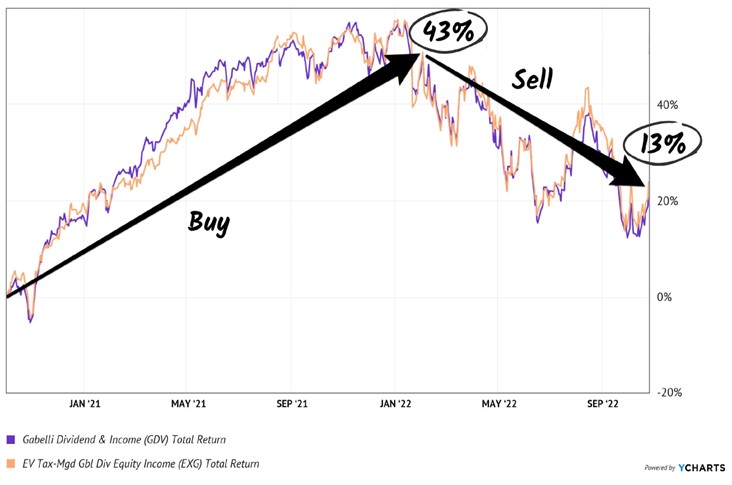
For whatever reason, “market timing” is a taboo phrase among long-term investors. That’s a shame because it is quite important.
By aligning our dividends with the market backdrop, we can protect our principal from bear markets.
Step 6: Start Here to Retire on $500K
So if the “tried and true” money advice — like the 60/40 portfolio and the 4% rule — has been properly exposed as broken…
Where do we go from here?
Well, imagine your portfolio in just a few days or weeks from now spinning off 8%, 9% and even double-digit dividends with the reliability of a Swiss watch… with many of my recommendations paying every single month no less!
No more worrying how much is coming in next month.
No more worrying about the Fed’s next move.
No more worrying about outliving your nest egg.
Let me tell you more about my solution — what I call the 10% “No-Withdrawal Portfolio.”
Better yet, I want to give you the names of my favorite stocks and funds to buy right now…
Yields Up to 10%, With Upside
To make it easy to transition into this new way of investing… where you are buying “bird in the hand” cash flows… instead of stocks that you just hope will go up… I’ve prepared two in-depth guides that hone in on the strategies I mentioned above…
Special Report #1:
Monthly Dividend Superstars: Yields Up to 10%, With Double-Digit Upside
This is where you’ll find the bargains that investors are leaving on the table in their misplaced fear of the Fed.
 Inside you’ll find the ticker symbol, my buy-up-to price and in-depth backstory on my three favorite CEFs:
Inside you’ll find the ticker symbol, my buy-up-to price and in-depth backstory on my three favorite CEFs:
- A well-hedged 10% payer in one of the most in-demand sectors right now,
- The brainchild of one of the top fund managers on the planet, throwing off an amazing 8.6% yield,
- And a rock-steady 7.1% dividend whose managers have guided it to an astonishing 1,700% total return since inception.
Special Report #2:
The Perfect Income Portfolio
In this guide, you’ll get all the details of what I call the “Perfect Income Portfolio.”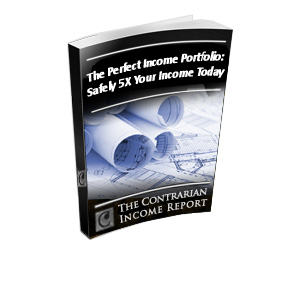
Step-by-step, I’ll show you exactly how to set up your portfolio for maximum income without taking on additional unnecessary risk.
And, if you follow the simple steps laid out, I’m confident you’ll be able to enjoy an income stream that far exceeds what most folks who buy the typical S&P 500 stock earn.
This report includes investments that have passed my strict due-diligence process—including one of the best ways I’ve ever seen to invest in utilities (which I’ve picked for strong gains as interest rates move lower starting later in 2025).
This fund pays a whopping 7.6% today, holds some of the strongest electrical utilities in the country and trades at a bargain valuation. Its bargain status won’t last as lower rates pull more investors toward its rich payout!
I’ll walk you through each recommendation, giving you a clear, concise and easy-to-understand breakdown of exactly why I see these as “perfect” income plays.
How to Get Both Reports Absolutely Free
To access both reports, Monthly Dividend Superstars and The Perfect Income Portfolio, at no cost whatsoever, I simply ask that you take a risk-free trial of my research service, Contrarian Income Report.
I created Contrarian Income Report to help investors uncover overlooked and underappreciated income plays before Wall Street and the mainstream herd bid them up.
People often ask me, “I get the income part, but where does ‘contrarian’ fit in?”
My answer is simple: You’ll never beat the market by following the herd.
If you buy the same investments as everyone else, you’re going to have the same results as other people — which are always mediocre. This is why my advisory is defiantly contrarian.
It all boils down to one simple principle: If you want to make money, really big money, do what nobody else is doing.
Contrarian investing is probably the simplest, sanest, most powerful and reliable money-making technique ever devised to buy low and sell high. It works in any market, from stocks and bonds to gold and real estate — because human nature is the same everywhere.
You don’t need special training. All you need is an independent mind, a bit of patience and an ounce of courage.
If you want to buy low and sell high, you must force yourself to buy when everybody, including yourself, is feeling discouraged — when the news is bad. That’s likely to be the bottom. And you should sell when everybody is excited and the news is good, because that’s likely to be the top.
Right now, we’re holding a diverse collection of these high-yielding stocks and funds, and you’ll get instant access to each one the moment your no-risk trial starts.
And every new investment you get in Contrarian Income Report comes with a simple goal: it will pay a reliable 5% dividend — or better.
In fact, some holdings in our portfolio go way further than that, delivering 12%+ income right now.



